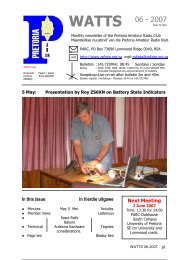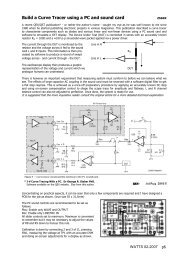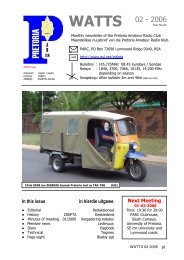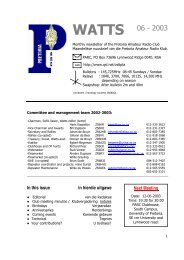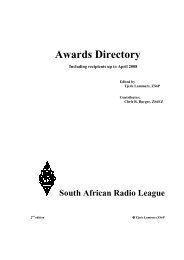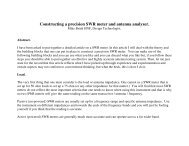Display - Pretoria Amateur Radio Club
Display - Pretoria Amateur Radio Club
Display - Pretoria Amateur Radio Club
Create successful ePaper yourself
Turn your PDF publications into a flip-book with our unique Google optimized e-Paper software.
WATTS<br />
11-2012<br />
Year 82 + 11m<br />
Monthly newsletter of the <strong>Pretoria</strong> <strong>Amateur</strong> <strong>Radio</strong> <strong>Club</strong><br />
Maandelikse nuusbrief van die <strong>Pretoria</strong> <strong>Amateur</strong> <strong>Radio</strong> Klub.<br />
PARC, PO Box 12602, Die Hoewes, 0163, RSA<br />
web<br />
http://www.parc.org.za mail: zs6pta@zs6pta.org.za<br />
ZR6FD logo<br />
Drukwerk<br />
ZS6RH<br />
Papier / Paper<br />
ZS6RH<br />
Bulletins: 145,725 MHz 08:45 Sundays/Sondae<br />
Relays: 1.840, 3.700, 7.066, 10.135, 14.235, 51.400, 438.825, 1297 MHz<br />
Activated frequencies are announced prior to bulletins<br />
Swapshop: 2m and 7.066 MHz Live on-air after bulletins<br />
Bulletin repeats Mondays | herhalings : Maandae 2m 19:45<br />
Your weekly EME bulletins come from here.<br />
ZS6OB Icom Hamshack<br />
In this issue<br />
In hierdie uitgawe<br />
Member news and activities Lede-nuus en Aktiwiteite<br />
Next fleamarkets<br />
and socials 2012<br />
Tentative 8 Dec.<br />
Venue: PMC,<br />
Silverton<br />
Technical Digital modes frequency list<br />
Mobile <strong>Radio</strong> Regulation 308A <strong>Club</strong> meeting: Tegnies<br />
Lead-acid battery desulphator<br />
Thursday 1 Nov<br />
● Page eight -- Bladsy agt<br />
U.P. <strong>Club</strong>house<br />
WATTS 11 -2012 p1
PARC Management team / Bestuurspan Aug. 2012 – Aug. 2013<br />
Committee members<br />
Chairman, Contests Pierre Holtzhausen ZS6PJH zs6pjh@telkomsa.net 012-655-0726 082-575-5799<br />
Vice Chairman, SARL liason Fritz Sutherland ZS6SF fritzs@icon.co.za 012-811-3875 083-304-0028<br />
Secretary, <strong>Club</strong>s, Strategy Jean de Villiers ZS6ARA zs6ara@webmail.co.za 012-663-6554 083-627-2506<br />
Treasurer, SARS Andre van Tonder ZS6BRC andreh.vtonder@absamail.co.za 361-3292 082-467-0287<br />
Rallies, Social Johan de Bruyn ZS6JHB zs6jhb@gmail.com 012-803-7385 079-333-4107<br />
Webmaster Graham Reid ZR6GJR greid@wol.co.za 083-701-0511<br />
RAE, Bulletin co-ordinator Vincent Harrison ZS6BTY zs6bty@telkomsa.net 012-998-8165 083-754-0115<br />
Repeaters, Technical Craig Symington ZS6RH zs6rh@hotmail.co.za 081-334-6817<br />
Technical, Kits. PR, youth Rudi van Dyk ZS6RVD vdykr@telkomsa.net 082-962-4141<br />
Co-opted/Geko-opteer:<br />
Auditor Tony Crowder ZS6CRO tcrowder@telkomsa.net 011-672-3311<br />
WATTS newsletter/Kits Hans Kappetijn ZS6KR zs6kr@wbs.co.za 012-333-2612 072-204-3991<br />
<strong>Club</strong>house Pieter Fourie ZS6CN pieter2@vodamail.co.za 012-804-7417 083-573-7048<br />
Fleamarket Alméro Dupisani ZS6LDP almero.dupisani@up.ac.za 083-938-8955<br />
Historian, Archives, Awards Tjerk Lammers ZS6P zs6p@iafrica.com 012-809-0006<br />
- Richard Peer ZS6UK ZS6UK@peer.co.za 012-333-0612<br />
<strong>Club</strong> members are invited to the following<br />
Digital Mode Frequencies<br />
SSTV: 3.730, 14.230, 21.340, 28.680 kHz USB<br />
DIGSSTV: 3.733, 14.240 kHz USB<br />
PSK31: 1.838.15, 3.580.15, 7.040, 10.140, 14.070.15, 21.080.15, 28.120.15 kHz USB<br />
PSK63: 14.072 kHz USB<br />
PSK31FEC: 14.074, 14.075 kHz USB<br />
MT63: 3.596, 14.109.5, 21.120, 28.130 kHz USB<br />
RFSM8000: 3.590, 3.740, 14.109 kHz USB<br />
FDMDV: 14.236 USB<br />
MFSK: 1.838, 3.580, 7.037, 14.080, 21.080, 28.080 kHz USB<br />
OLIVIA: 3.585, 7.038.5, 14.075.65, 14.104.5 to 109.5 kHz USB<br />
ROS: 14.103 USB<br />
PACTOR I FEC: 14.074 to14.076 kHz USB<br />
JT65A: 14.076 USB<br />
FSK441-JTMS: 144.370 USB<br />
WSPR: 7.0387, 10.1387, 14.0957 kHz USB<br />
WATTS 11 -2012 p2
Birthdays<br />
Nov<br />
Verjaarsdae<br />
Nov Anniversaries<br />
Herdenkings<br />
03 Blaine, son of Heather and Vince ZS6BTY 04 Estelle en Simon ZS6AST ( 40 )<br />
06 Solly ZS6SV 05 Nina and Edwin ZR6ESP ( 2 )<br />
07 Andrew, seun van Lynn en Andre ZS6BRC<br />
10 Luther ZS6E ( 96 )<br />
11 Peggy, sw of Ed ZS6UT<br />
12 Emmerick, seun van Erna en Whitey ZS6JJJ 22 Caitlin, daughter of Heather and Vince ZS6BTY<br />
12 Fritz ZS6SF 25 Gordon ZS6AGV<br />
16 Jean, dogter van Lynn en Andre ZS6BRC 25 Tony ZS6CRO<br />
16 Vlasta, ZS6-2501, sw of Ivan ZS6CCW 26 Bridge ZS6BJM ( 81 )<br />
19 Joe ZS6TB 27 Janice, dogter van Ellen en Joe ZS6AIC<br />
22 Chris ZS6BGH/ZS3B 27 Karin, sw van Sarel ZS6EK<br />
Lief en Leed | Joys and Sorrows<br />
Bridge ZS6BJM se LV herstel goed na ‘n beroerte.<br />
John ZS6JAO ‘s SW was in hospital.<br />
Magda ZS6MVW was kortliks in die hospitaal<br />
Nuwe lid<br />
Welkom aan Nico Swart van Silverton<br />
Ridge wat onlangs sy RAE geskryf het.<br />
Diary | Dagboek (UTC times) PARC meeting 1 Nov 19:00<br />
Nov.<br />
Vincent ZS6BTY will discuss antennas for<br />
04 DARC 10m Digital Contest 11:00-17:00 HF DXing specifically on 10-20m but will touch<br />
10-11 WAE RTTY DX Contest 00:00-23:59 on 40-160m as well.<br />
10-11 JIDX Phone Contest 07:00-13:00 The discussion will be around the effect of<br />
10-11 OK/OM DX Contest 12:00-12:00 antenna height on the angle of radiation, why<br />
16 YO International PSK31 contest 16:00-22:00 it matters and what is practically achievable.<br />
17-18 SARL Field Day contest 10:00-10:00 Finally he will touch on what sloping ground<br />
17-18 LZ DX Contest 12:00-12:00 around the antenna can do for you.<br />
24-25 CQWW DX CW Contest 00:00-24:00 Anyone is welcome.<br />
30-Dec02 ARRL 160m Contest22:00-16:00 The talk will start at 19:30.<br />
Snippets | Brokkies<br />
NB: PARC committee meetings take place<br />
every 2 nd Thursday evening at 7pm.<br />
Any member is invited to attend either as a<br />
backbencher or participant with positive<br />
input.<br />
DXpedition to Lesotho:<br />
23 November – 3 December<br />
Roger ZS6RJ reports the following<br />
operators will be active :<br />
Donovan, ZS2DL (CW); Mitch, ZS2DK<br />
(SSB, RTTY); Roger, ZS6RJ (CW)<br />
Jo, DJ3CQ (CW); Chris, DL2MDU<br />
(CW);Emil, DL8JJ (CW)<br />
Frosty, K5LBU (SSB, RTTY); Keith, VE7MID (CW); Neil, VA7DX (CW)<br />
“We're still finalizing equipment, but it will be a mix of IC-7600, Elecraft<br />
K3's on the radio side and IC-PW1's / Expert 1KA and 2KA / Elecraft KPA 500<br />
linears, with antennas being Tennadyne T6 Log periodic, a spiderbeam and a<br />
hexbeam with a mix of verticals and a battlecreek special for low bands.<br />
Quite an arsenal…”<br />
WATTS 11 -2012 p3
<strong>Radio</strong> Equipment in your vehicle & roadblocks<br />
It has been brought to the attention of HAMNET that on occasions, either Hamnet members or normal radio<br />
enthusiasts have had a bit of an altercation with roadblocks on our national roads.<br />
Members of SAPS or Provincial Police have been rather ‘difficult’ in their conversations and demanding documentation<br />
and authority to ‘have radios in your car’.<br />
Francois ZS6BUU will be discussing this issue with the SAPS at the SASAR conference which is taking place this month<br />
– and if necessary he will take it further up the line of authority with SAPS to ensure we get clearance on this issue!<br />
In the mean time, Francois having been on the road for many years, the safest scenario is to have a certified copy of<br />
your current ICASA licence with you, and if available, your original license to operate amateur radio.<br />
Please also ensure that your call sign, as it appears in your certificate, is visible on your mobile equipment.<br />
What he also suggests – especially for those constantly on the road with equipment in their vehicles; have a copy of<br />
Regulation 308 A in your possession to show any official that ‘land mobile vehicles’ are allowed to carry radio<br />
equipment and are exempt from the restrictions related to cell phones.<br />
He suggests you have a clearly marked envelope in your cubby hole specifically designed to carry all the<br />
documentation needed to establish your credentials!<br />
Cell phones are totally another issue so please do not hold your hand held in your hand when driving – this is<br />
courting disaster as no official will know the difference between a cell phone and a two way radio!<br />
Government Gazette<br />
Vol. 423, No. 21569, 22 September 2000<br />
Regulation Gazette, No. 6882<br />
No. R. 941<br />
NATIONAL ROAD TRAFFIC ACT, 1996 (ACT NO. 93 OF 1996)<br />
AMENDMENT OF THE NATIONAL ROAD TRAFFIC REGULATIONS<br />
The Minister of Transport has under section 75 of the National Road Traffic Act, 1996 (Act No. 93 of<br />
1996), made the regulations in the Schedule.<br />
Definition<br />
SCHEDULE<br />
1. In this Schedule "the Regulations" means the National Road Traffic Regulations published in<br />
Government Notice No. R. 225 of 17 March 2000, as amended by Government Notice No. R. 761<br />
of 31 July 2000.<br />
Amendment of regulation 308A of the Regulations<br />
2. Regulation 308A of the Regulations is amended by the substitution in subregulation (3) for<br />
paragraph (b) of the following paragraph:<br />
"(b) the phrases "cellular or mobile telephone or any other communication device" and "cellular or mobile<br />
telephone or other communication device", excludes land mobile radio transmission and reception<br />
equipment operating in the frequency band 2 megahertz to 500 megahertz that is affixed to<br />
the vehicle or is part of the fixture in the vehicle.".<br />
Insertion of regulation 343C in the Regulations and Validation of things done by local<br />
authorities<br />
3. blah blah …<br />
Short title<br />
4. These regulations are called the Second Amendment of the National Road Traffic Regulations.<br />
WATTS 11 -2012 p4
Contesting tips It’s that time of year again with 48hr contests -<br />
90 minutes - this is the length of a typical human sleep cycle.<br />
From the first loss of consciousness, through rapid-eye-movement (REM) deep sleep, and back to shallow sleep.<br />
Timing your contest naps to last for about 90 minutes avoids the grogginess of being awakened mid-cycle.<br />
This eham.net article http://www.contesting.com/articles/37cookietest=1 by K5ZD goes in to some detail about how to manage<br />
those all-important mid-contest ZZZZs - and we are not talking about South Africa!<br />
Be Nice To The Moon (and Mars) by Robert Krulwich ( eham.com )<br />
All over the world, ham radio operators and Morse code enthusiasts beam dot, dash messages straight at the moon, then wait 2.7<br />
seconds for the signal to bounce back. They call these "E.M.E." transmissions, which stands for "Earth-Moon-Earth" or — more<br />
popularly — "moonbouncing." I suppose it's fun to smack little beeps against a sleepy rock 239,000 miles away and have those<br />
beeps come flying back at you. Plus, it's easy.<br />
Moonbouncing With The Morse Resource<br />
Anybody with a good transmitter and an antenna "capable of being rotated in both the azimuth and elevation planes" can bounce<br />
messages off the moon. You don't even have to know Morse code. There's a shortcut. Just type your message ("Happy Birthday,<br />
Munchkins!") onto a screen at The Morse Resource and in less than a minute they translate it into long and short beeps you can<br />
hurtle moonward.<br />
The moon must be twitching!<br />
Beethoven's Sonata In Morse<br />
Code<br />
Not so long ago, a Scottish artist,<br />
Katie Paterson, turned Beethoven's<br />
Moonlight Sonata into Morse code<br />
(yup, you can do that, too) and<br />
bounced it off the moon. Some<br />
musical phrases got trapped in moon<br />
craters and didn't come back, which<br />
she found so intriguing, she put the<br />
ricocheted, fragmented Moonlight<br />
Sonata on a player piano and you can<br />
now see her moonbounced, Morsecoded<br />
piece being not performed by<br />
anyone, the keys going up and down<br />
on their own, on YouTube.<br />
The latest took place in the dirt of<br />
Mars itself. A few weeks ago, NASA<br />
began testing its newest rover,<br />
Curiosity. They turned it on and let it<br />
move a little, and it turns out<br />
Curiosity's wheels have little grooves<br />
in them that are dots and dashes of<br />
Morse code, spelling J ... P ... and L ...<br />
for Jet Propulsion Laboratory. You can<br />
see them here.<br />
NASA/JPL-Caltech picture.<br />
Why dig Morse-coded signals into the<br />
soil on Mars So that NASA can look<br />
down from orbiters above and<br />
measure how far the rover has gone.<br />
Every time they see a new "J", "P"<br />
and "L" in Morse, they know the rover<br />
has moved a full turn of its wheels,<br />
which is a specific distance.<br />
It's like a measuring stick.<br />
WATTS 11 -2012 p5
Lead-Acid Battery Desulfator by Alistair Couper from Home Power #77<br />
Ed: Article abridged from three pages and the gist extracted. Note the author lives off-grid and has no generator)<br />
It is not true that a big battery bank is better than a small one. An oversized battery bank can be almost impossible to charge<br />
properly. Without a minimum daily exercise regimen it can become the equivalent of a couch potato. The main culprit is sulfation,<br />
which is a gradual crystallization of the battery’s plate material, rendering it electrically inactive.<br />
The usual practice of keeping a battery in good condition is to apply a periodic equalization charge over and above what would be a<br />
normal full charge. Unfortunately this is an energy wasting tactic. Ultimately it runs in clean battery plates, but at a steep price,<br />
especially if the energy must come from a generator.<br />
Over the last twenty years a wealth of ideas and strategies for charging and electrically desulfating batteries has been published.<br />
Virtually all of the devices and patents involve pulsing charge current. This is in contrast to the constant or slowly varying currents<br />
generated by for instance solar panels.<br />
A useful technique distilled from this information relies on a little known aspect of lead-acid batteries. They possess what is called a<br />
“resonant frequency” at a surprising high frequency dependent on the various physical details of construction, but is in the order of<br />
2 to 6 MHz.<br />
The right frequency at sufficient energy will<br />
“pluck” or vibrate sulfur ions back and forth<br />
through the electrolyte. There are then<br />
unaccountable collisions between the ions and the<br />
battery plates where this rhythmic beating slowly<br />
but surely causes the breakup of the crystalline<br />
deposits.<br />
A circuit to do this is in essence a very widely used<br />
form of switching DC-DC converter. Fig. 1 shows<br />
the version specifically for 12V systems. The basic<br />
pulse rate is set by the venerable 555 timer chip<br />
U1 which switches the MOSFET Q1 at a 1 kHz<br />
rate. When Q1 is non-conducting, current is drawn<br />
from the battery through L2 sothat capacitor C4<br />
can be charged slowly. Then Q1 is turned on for a<br />
brief 50 uS causing the charge stored in C4 to<br />
start flowing through L1.<br />
When Q1 is turned off again, the stored inductive energy in L1 has to continue to flow somewhere, so it pulses back into the battery<br />
through diode D1. This current pulse can get as high as 6 Amps. The peak voltage drop across the battery can be as high as 50<br />
volts. With continued treatment this will decrease as the battery’s internal resistance gradually declines.<br />
If an oscilloscope is available it is easy to observe the ringing waveform across the battery terminals. There may be more than one<br />
frequency due to all the wiring and other details.<br />
Be careful to work in a well ventilated area. Depending on the battery case and inductors used, a faint audio tone can be heard.<br />
There is no reverse polarity protection in this circuit so make sure to connect correctly.<br />
Usage.<br />
Take note that pulsing energy to and from the battery happens at less than 100% efficiency. The circuit draws about 40mA from the<br />
battery, so some additional charging source is needed. I simply clip the circuit across the battery terminals in parallel with a 30 W<br />
solar panel. When external equipment such as an inverter or power supply is connected then additional low impedance paths are<br />
The current pulses will happily flow down these paths as well and are thus lost. The impedance of such equipment is however not<br />
very low at 1 MHz and above but adding ferrite chokes or clamp-on ferrites over the battery leads will prevent problems.<br />
The circuit as shown is strong enough to maintain a battery bank of several hundred Ah. For larger banks, fine tuning the inductors<br />
and the on time of Q1 will be necessary. If you want to power the circuit from an auxiliary voltage source so that the battery being<br />
treated remains trickle charged, simply remove R3 and place 12V across C1.<br />
It is best to construct the unit in a metal case otherwise it is likely to generate a fair bit of radio interference.<br />
Does it work<br />
If badly sulfated batteries are treated, it is convenient to use a trickle charger of one or two amps. The simplest way to see if this<br />
circuit is having an effect is to note that the terminal voltage actually drops each day. Also the SG of the electrolyte should begin to<br />
rise slowly.<br />
Healthy batteries<br />
I have used this circuit in my main system for over a year and have not seen the need to equalize in that time. All of the cells’<br />
electrolyte levels remain in step with each other and there have been no problems starting big loads – a sure sign of battery health.<br />
Patience is required in reclaiming weak and tired batteries, and no amount of desulfating will help a battery with a shorted cell, or<br />
one that has lost plate material through excessive use.<br />
This device is useful for batteries that sit for long periods. If you use a generator for equalization this technique is a must. When you<br />
live off-grid, silence is golden.<br />
WATTS 11 -2012 p6
U. S. Noise Production<br />
Reaches New High<br />
May 29, 1948, edition of the Saturday Evening Post<br />
PERHAPS nowhere since man began to think has the escape into the quiet of his<br />
thoughts been made more difficult than it is in America today.<br />
To blame radio for this is to oversimplify. The industry is properly held responsible for<br />
the many sins it commits in the name of entertainment and for its often hideous<br />
irrelevance, but the hand controlling the buttons of the individual radio receiver is the<br />
prime offender.<br />
There are so many hands controlling so many buttons that to hope for relief from the<br />
scourge of radio noise seems almost foolish. It boils down to a question of manners. Is<br />
it foolish to hope that the member of the family who loves noise for its own sake will<br />
develop the decency to limit his odd appetite Or that the apartment dweller who keeps<br />
his radio going loudly most of the day and night will have mercy on his neighbors<br />
cowering behind thin walls Perhaps, but there is no harm in hoping.<br />
There is no harm, either, in hoping that the newsreel companies will someday refrain<br />
from enhancing the horror of disaster pictures by the addition of apocalyptic<br />
commentary and foreboding music jerked from the bowels of Wagner; that the listening<br />
public will someday get help to the fact that the squalid self-dramatization of the loudmouthed<br />
journalistic statesmen of radio is merely so many unnecessary decibels; that<br />
someday the American hostess will abandon her notion that a perpetual yackety-yak,<br />
however pointless, is necessary to the success of her parties; and that municipal<br />
authorities will get tough with the mobile loud-speakers which range the streets,<br />
expectorating racket into the ears of workers who are trying to think.<br />
Meanwhile, for the protection of the harassed fugitive, there remain these three<br />
retreats- the soundproofed room, total deafness, and the public library, and the greatest<br />
of these is the public library. May God rest the soul of Andrew Carnegie, who fashioned<br />
better than he thought.<br />
Ed: Besides less use of public libraries nothing much has changed<br />
QRV Services offers the following expertise:<br />
General equipment and TV repairs<br />
Small-scale design and manufacturing<br />
Frequency and power calibration<br />
Technical writing<br />
3 rd Party scrutiny of projects and documents<br />
MFJ 259/69 Analyzer repairs and calibration<br />
Valuation of ham estates and their disposal<br />
and products:<br />
Legal limit 30m and 40m dipole traps<br />
Linear power supply O.V. protection kits<br />
30A DC switching supplies<br />
Nissei SWR/Power meters HF and VHF/UHF<br />
Connectors RF and DC<br />
Plug-in triple sequential industrial timer<br />
Contact Hans at 012-333-2612 or 072-204-3991<br />
WATTS 11 -2012 p7
MHz<br />
F2 Critical Frequency and 4000 km MUF<br />
<strong>Pretoria</strong> - November 2012<br />
Long Term HF<br />
Propagation Prediction<br />
for November 2012<br />
Courtesy ZS6BTY<br />
35<br />
28<br />
21<br />
14<br />
foF2<br />
MUF East<br />
MUF North<br />
MUF West<br />
MUF South<br />
(see also our website propagation<br />
tab)<br />
DX Operating<br />
The graph shows the 4000 km maximum<br />
useable frequency (MUF) to the East,<br />
North, West and South from <strong>Pretoria</strong> for<br />
the first hop using the F2 layer.<br />
7<br />
0<br />
0 2 4 6 8 10 12 14 16 18 20 22 24<br />
UTC<br />
Local Operating<br />
The F2 critical frequency (foF2) is the<br />
maximum frequency that will reflect<br />
when you transmit straight up. E-layer<br />
reflection is not shown.<br />
Last month’s clock in more detail and another called the “Engineers” clock….<br />
The central design may look like a bungled biohazard symbol, but it in fact is another three-nine reference, the "hurricane" symbol<br />
of a high-IQ organization called the Triple Nine Society. (check it out)<br />
This one differs a little from last month’s at the one o’clock position.<br />
Math enthusiasts who don't want to move totally into the digital realm might appreciate this analog clock.<br />
Each number is expressed as a calculation involving three instances of the number 9.<br />
For example, 5 o'clock is the square root of nine (3), factorial (3x2x1 = 6), minus 9/9 (6-1 = 5).<br />
The trickiest time is 7 o'clock, whose calculation works out to 6.99999..., with an infinite number of nines.<br />
Wikipedia assures us that 0.99999... really does equal 1, so no worries about cheating here..<br />
How many AA batteries would it take to power a standard adult human for one day<br />
A Manganese/Alkaline AA cell it rated at about 2.4 amp-hours. If we assume 1.5 volts average this gives approximately 3.6 watthours<br />
(slightly optimistic). Since there are 3,600 seconds in an hour this is equivalent to 12,960 Joules.<br />
A human consumes about 2,000 calories/day. A dietician calorie is equal to 1,000 engineering calories.<br />
A calorie is equal to 4.2 Joules.<br />
Therefore this is equivalent to 2,000 * 1,000 * 4.2 = 8.4 * 10 6 Joules per day.<br />
Dividing one by the other you will need about 648 AA cells to power a human for one day.<br />
This assumes that the power from the AA cell will go through the same inefficiencies as the chemical processes in a human. (A<br />
human runs at about 20% efficiency chemical energy to mechanical energy).<br />
If we can circumvent this inefficiency we would only need 20% of this number of cells - say 130 cells.<br />
WATTS 11 -2012 p8



